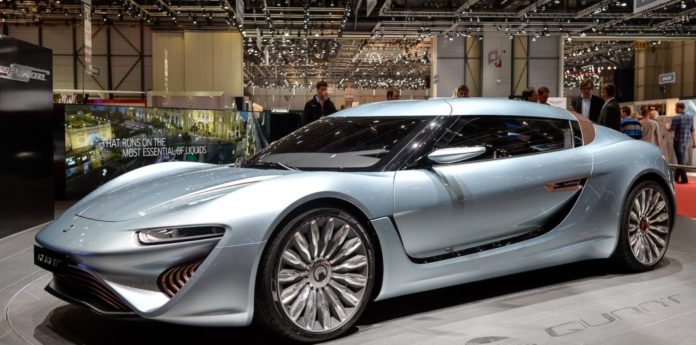
No, this is not a “run your car on water” scheme, it’s actually real technology that’s been in the works for years.
A European company called Nanoflowcell has come up with a way to run a car on salt water. Well, maybe not YOUR car but A car. To be technically correct, the salt water is used as a storage medium or battery rather than a fuel. The “Quant” E sport limousine is a 100% electric car. No hybrid, no fossil fuel, no emissions other than water vapor. On paper the company boasts this car to put out over 900 HP from 4 electric motors driven by this flow cell battery. The sleek design also makes the car competitive with sports cars and electric cars alike. But beyond aesthetics, the Quant also proves its worth in performance. The e-Sport limousine clocks a top speed of 217 mph, on par with a McLaren P1, and delivers an average projected range of 310 miles, higher than that of Tesla Model S’s estimated 260-mile range. As a bonus, it’s also coated with a complete membrane of solar energy gathering cells and power regenerating brakes to help produce as much electricity as possible … and the list goes on. You can check out a video from the company here.
So how does it work? You ask. “Flow” battery technology has been lurking about for a number of years. Companies such as Primus power, Redflow and Tesla have been building these batteries referred to as “regenerative fuel cells” for a few years. The biggest difference between a regular “acid battery” and flow cell is that the electrolyte does not just sit in a container nibbling away at conductive plates like ants on a cracker. There are typically two storage tanks, one with positively charged fluid and one with negatively charged fluid. Two pumps force the fluids through a divided chamber and the reaction creates electric energy. The amount of power possible is directly related to the size of the tanks. Sounds like a simple concept until you get into the chemical concoctions. What does it mean for the regular people of the world? For one, not only has this company convinced Germany and the European union to let them legally register the car, it’s now legal for it to be personally owned and operated throughout. Knowing how the Germans embrace and refine technology it could mean a big difference to the world.
That’s great! You say to yourself. What’s it gonna do for the rest of us? As far as the technology itself goes, stop and think for a second. Since the NanoFlowcell® itself has almost no moving parts, in theory, there are no limits to the scale of this energy system. Those of the population living in rural areas, islands, preppers of all kinds, isolated towns and those just wanting to keep more of their hard earned pennies may now have another alternative power source for those times when solar and wind just aren’t happening. The long term benefits are obvious… well, as long as “big energy” embraces it instead of trying to bury it… we the people could have a major jump on the ability to store and produce continuous amounts of clean energy.
Will the technology survive and evolve into a viable and affordable means of producing energy? Only the shadowy figures of corporate espionage know that one.
What do you think?
TechAnon
This Article (A car that runs on salt water) is free and open source. You have permission to republish this article under a Creative Commons license with attribution to the author and AnonHQ.com.
Reference:
Newsletter. (2014, July 22). Retrieved 13 November 2015





…after this short media report, I doubt we will hear anything else about it for many years to come.
SCAM,,,, SCAM —– SCAM – Sorry
Anyone can say “scam.” Prove it.
That car is running on salt water like my car is running on whatever my gas tank is made of. That is simply an electric car with an unusual battery technology, where the energy is stored in the electrolyte instead of the electrodes. In reality, it is running on whatever was used to charge the battery. Sure, the car’s solar cells will provide a small amount of power, but unless the owner has his own huge solar charging station, most of the power to charge the battery will come from being plugged into the electric grid.
The “Quant” E sport limousine because it would have to be, to scale, the lenght of a limo and proportionate to the length the height of what woudl be enough salt water to create anywhere near the electrical charge required to motorise and propell a vehicle whilst maintaining the light weight of a dinky without the weight of water. Water finds it’s own level as my father says.
veritable hydrogeneration cars
I heard they wouldn’t use this for buses because of how volatile they might be in a collision. I hate to spoil the fun. I would like this to be real obviously. In a perfect world maybe. Realistically though. Maybe I am wrong. Driving what is potentially a hydrogen bomb is a tad too riskue.
And gas isn’t volatile? What makes the two fluids volatile? What are the two fluids? Are they simple to produce? Can solar or wind systems efficiently create the fluids?
Obviously, I am not acquainted with this technology but really interested.
why create a sports car, why not a full sized, extended cab, pickup truck? save more gas, and the roads won’t allow that much speed, with that horse power you could run semi tractors; or even put john deere out of business
When they develop a viable, powerful, high torque, reasonably priced one ton crew cab 4×4…let me know!
Hell yes! I’m all for it! George Bush Jr once said “This country is addicted to oil”….